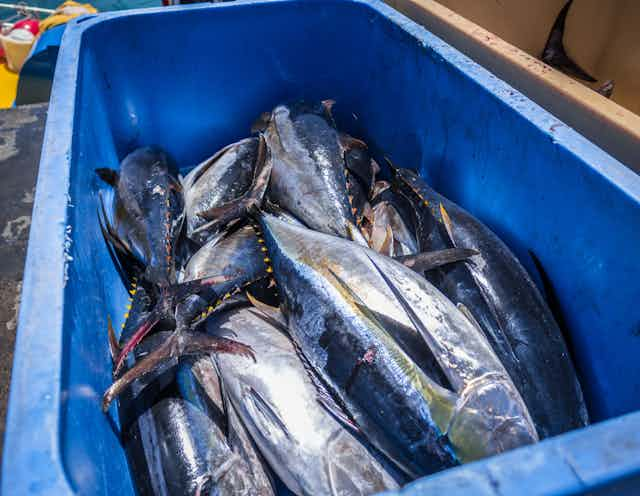Atlantic bluefin tuna used to be caught only relatively rarely, mainly by sports fishermen in North America. But this all changed in the 1950s when consumers of sushi, particularly in Japan, developed more of a taste for the species.
Historically, Atlantic bluefins have either been caught directly from the ocean or caught while young and fattened in large offshore cages called “ranches”. Both wild fishing and ranching pose sustainability issues since they involve taking fish from the wild. The surge in demand resulted in excessive fishing pressure. By 2006, the International Commission for the Conservation of Atlantic Tunas warned that the Atlantic bluefin stock was close to collapse.
Scientists are now exploring ways to breed Atlantic bluefin tuna in captivity as an alternative to catching young fish from the sea. These approaches involve the manipulation and release of hormones into the water to stimulate egg production in the fish. The resulting eggs and fish larvae are then kept in a series of tanks until they grow to a suitable size, at which point they are relocated to cages at sea.
In a significant breakthrough in July 2023, scientists at the Spanish Institute of Oceanography successfully bred Atlantic bluefin tuna in tanks on land for the first time. This development has been seen as a win for sustainability. By breeding fish in enclosed tanks, fewer Atlantic bluefins will need to be caught from the wild.
But there are concerns surrounding the welfare of farmed tuna and their environmental impact. Atlantic bluefins are not well suited to captivity as ordinarily they migrate over thousands of miles of open ocean. Research also suggests that the methods used to get the tuna to spawn may cause them stress.
Welfare in hatcheries
An astonishing proportion of tuna larvae die in the hatcheries. In the EU’s early Atlantic bluefin domestication project, called Transdott, which started in 2012, only 0.44% of tuna larvae survived 30 days after hatching.
This death rate seems shockingly high. But an extremely high number of tuna larvae die in the wild as well. Hatcheries may also become better at preventing some of these deaths in future, since they will struggle to make a profit if most of their stock dies.
There are, however, causes of death within hatcheries that don’t exist in the wild. Some larvae die by crashing into tank walls and others perish when they are moved between tanks.
It’s difficult to assess the day-to-day experience of tuna in hatcheries. Part of the reason for this is because conditions in hatcheries are often kept private. But undomesticated species of fish generally experience greater stress in captivity and in response to human handling than domesticated species, which have adapted to this over time.
Since we are in the early stages of the domestication process for Atlantic bluefins, we should expect the tuna to be stressed by the large degree of human contact.
There is also some evidence that fish can become distressed by noise and are unaccustomed to vibrations. But noise may be hard to avoid on farms, particularly inland. One study found that guppies exposed to chronic noise exhibited a significantly shorter lifespan compared with those in either acute noise or noise-free conditions.
On a more positive note, it’s in producers’ interests to ensure that their fish have good welfare and are not distressed. Research has found that stressed fish don’t taste as good, so they don’t fetch as high a price.

The transfer of young tuna to offshore enclosures raises several environmental concerns. Tuna are fed substantial amounts of frozen fish, such as mackerel and sardines, and there is always at least some uneaten. Research has shown that this residual feed, when combined with fish faeces, reduces biodiversity directly below the tuna cages.
Other species of fish that are kept in captivity, such as Atlantic salmon, often experience high numbers of parasitic infestations because they are packed so closely together. Research suggests that higher stress levels can render fish more susceptible to diseases too. As tuna farming operations grow, there will probably be a need to use more antimicrobials to treat disease outbreaks.
Slaughtering methods
The most common way of slaughtering large Atlantic bluefins is to shoot the fish in the head while they are still underwater. This method should theoretically cause minimal suffering as the fish usually die instantly. However, it’s not yet clear how easy it is for farm workers to get this technique right.
Smaller tuna are slaughtered in a way that probably causes them more suffering. The fish are crowded before slaughter, sometimes for several hours, which causes distress. They are then hauled out of the water and stabbed in the head with a metal spike (a process called “coring”). Fish can be mis-cored, meaning that they don’t lose consciousness immediately.

The extent of welfare concerns in Atlantic bluefin tuna hatcheries remains uncertain. But it’s worth noting that many of the factors that are detrimental to fish welfare may also have negative consequences for companies in the industry.
High death rates can hinder profitability, while stressed fish may be less palatable and, as a consequence, less valuable. As the industry evolves, there may be inherent incentives for companies to improve the welfare conditions for farmed Atlantic bluefin tuna.

Don’t have time to read about climate change as much as you’d like?
Get a weekly roundup in your inbox instead. Every Wednesday, The Conversation’s environment editor writes Imagine, a short email that goes a little deeper into just one climate issue. Join the 20,000+ readers who’ve subscribed so far.

